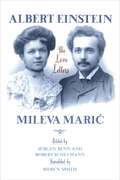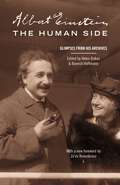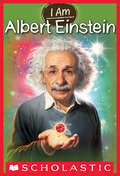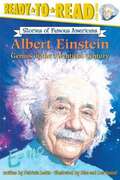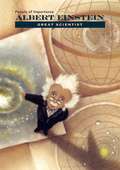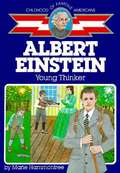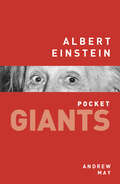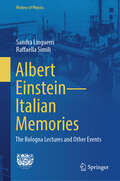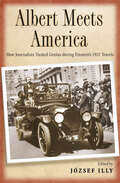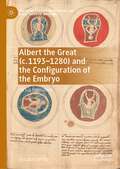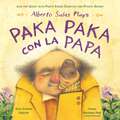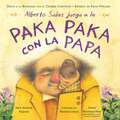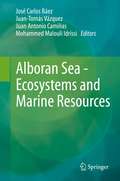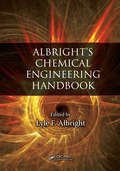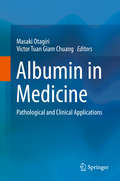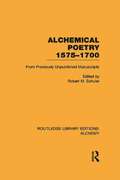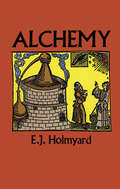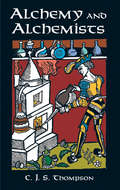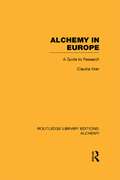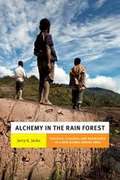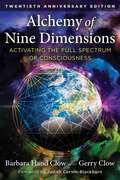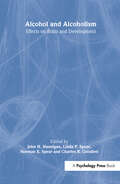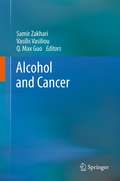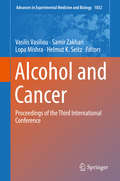- Table View
- List View
Albert Einstein, Mileva Maric: The Love Letters
by Albert EinsteinIn 1903, despite the vehement objections of his parents, Albert Einstein married Mileva Maric, the companion, colleague, and confidante whose influence on his most creative years has given rise to much speculation. Beginning in 1897, after Einstein and Maric met as students at the Swiss Federal Polytechnic, and ending shortly after their marriage, these fifty-four love letters offer a rare glimpse into Einstein's relationship with his first wife while shedding light on his intellectual development in the period before the annus mirabilis of 1905. Unlike the picture of Einstein the lone, isolated thinker of Princeton, he appears here both as the burgeoning enfant terrible of science and as an amorous young man beset, along with his fiance, by financial and personal struggles--among them the illegitimate birth of their daughter, whose existence is known only by these letters. Describing his conflicts with professors and other scientists, his arguments with his mother over Maric, and his difficulty obtaining an academic position after graduation, the letters enable us to reconstruct the youthful Einstein with an unprecedented immediacy. His love for Maric, whom he describes as "a creature who is my equal, and who is as strong and independent as I am," brings forth his serious as well as playful, often theatrical nature. After their marriage, however, Maric becomes less his intellectual companion, and, failing to acquire a teaching certificate, she subordinates her professional goals to his. In the final letters Einstein has obtained a position at the Swiss Patent Office and mentions their daughter one last time to his wife in Hungary, where she is assumed to have placed the girl in the care of relatives. Informative, entertaining, and often very moving, this collection of letters captures for scientists and general readers alike a little known yet crucial period in Einstein's life.
Albert Einstein, The Human Side: Glimpses from His Archives
by Albert EinsteinModesty, humor, compassion, and wisdom are the traits most evident in this illuminating selection of personal papers from the Albert Einstein Archives. The illustrious physicist wrote as thoughtfully to an Ohio fifth-grader, distressed by her discovery that scientists classify humans as animals, as to a Colorado banker who asked whether Einstein believed in a personal God. Witty rhymes, an exchange with Queen Elizabeth of Belgium about fine music, and expressions of his devotion to Zionism are but some of the highlights found in this warm and enriching book.
Albert Einstein: Albert Einstein (I Am #2)
by Grace NorwichMeet the scientist who changed the way we think about the universe!I am one of the most gifted minds that ever lived. I am a Nobel Prize–winning physicist. I was expelled from school as a young child. I am Albert Einstein.Learn all about this brilliant man whose scientific accomplishments are truly remarkable in this biography featuring:illustrations throughouta timelinean introduction to the other people you’ll meet in the bookmapssidebarsa top ten list of important things to know, and more
Albert Einstein: Genius Of The Twentieth Century (Ready-to-Read Sofa)
by Patricia LakinFrom a young age Albert Einstein was curious and very smart. But that didn't mean life was easy for him. In fact, being so smart sometimes made things harder for him! Read all about his life, and find out why Albert Einstein is known as the genius of the twentieth century.
Albert Einstein: Great Scientist
by Anne Marie SullivanAs a child, Albert Einstein was quiet and awkward. He had trouble making friends and problems with learning in the classroom. As Albert grew up, he began to use his mind in ways he didn't learn in school, leading him to become an expert in math and science. Einstein's ideas helped change the way scientists thought of the world around us and change the course of history in the atomic age. Today, Einstein is one of history's most famous scientists, and his theories have shaped science for decades. Learn about one of the most important scientists of all time in Albert Einstein: Great Scientist.
Albert Einstein: Young Thinker (Childhood of Famous Americans Series)
by Marie HammontreeAll children know who Albert Einstein grew up to be--but what was he like as a child? A fictionalized biography of the childhood of the famous scientist.
Albert Einstein: pocket GIANTS
by Andrew MayEveryone has heard of Albert Einstein and everyone knows that he was a genius. Yet only a few people understand his work. In fact, he was just one of many brilliant scientists grappling with the deepest problems of theoretical physics during the first half of the twentieth century. He may not have been the most important or influential of them – the point is arguable – but there is no doubt he was the most revolutionary. Almost single-handed, he transformed the way the world thinks about light, matter, space and time.In the sixty years since his death Einstein has become a legend. The profound obscurity of his theories has contributed to this, as has his archetypal “mad scientist” appearance. His philosophical and political utterances – both real and imagined – are regularly used to clinch arguments online or in the pub. So how can a modern reader separate myth from reality? This short book attempts to do just that!
Albert Einstein—Italian Memories: The Bologna Lectures and Other Events (History of Physics)
by Sandra Linguerri Raffaella Simili (deceased)This book is dedicated to Einstein’s personal and scientific relationships with Italy, which began as early as adolescence and continued over various stages of his life. It collects together a wealth of historical documentation including the letters in which Einstein recalls having lived as a young man with his family in Lombardy, Pavia and Milan; the texts of three lectures delivered by Einstein in Italian in October 1921 in Bologna at the invitation of the mathematician Federigo Enriques, the only lectures he held in Italy; the correspondence with Enriques and other Italian intellectuals, together with the letter that Einstein sent in 1931 to the Minister of Justice Alfredo Rocco to try to avoid the infamy of the oath of allegiance to the fascist regime imposed by Mussolini on university professors. The book closes with some writings on relativity from 1907 to 1914 (Einstein, Abraham, Corbino, Castelnuovo) and the 1920s debate between pro-relativists and anti-relativists publishedin the international journal “Scientia”, founded in 1907 by Enriques.
Albert Meets America: How Journalists Treated Genius during Einstein's 1921 Travels
by József IllyIn 1919, newspaper headlines said that a British expedition had confirmed Einstein's general theory of relativity. The news stirred the public imagination on both sides of the Atlantic and thrust the scientist into the spotlight of fame. Two years later, Chaim Weizmann led a fund-raising mission to the United States and invited Einstein to join it. The mission traveled to New York, Boston, Chicago, Cleveland, Philadelphia, and Hartford to campaign for public awareness and support of the Hebrew University of Jerusalem. This brought Einstein within the grasp of the American media. His lectures delivered in New York, Princeton, and Chicago, and comments on the Jewish presence in Palestine, made Einstein, on his first trip to America, one of the first media stars. In Albert Meets America, József Illy presents a fascinating compilation of media stories of Einstein’s tour—which cover his science, his Zionism, and the anti-Semitism he encountered. As we travel with Einstein, from headline to headline, we experience his emotional connection with American Jews and his frustration at becoming world famous even though his theories were not truly understood. This exciting collection gives readers an intimate glimpse into the life of one of the world’s first modern celebrities and a unique understanding of the media's power over both its subject and its audience.
Albert Meets America: How Journalists Treated Genius during Einstein's 1921 Travels
by József IllyThis volume of news articles from Einstein’s first trip to America explores his rise a public figure and the creation of his celebrity persona.When a British expedition confirmed Albert Einstein’s general theory of relativity in 1919, the news catapulted the German physicist to global fame. Two years later, he joined a fund-raising tour through the United States—a country he’d never seen before—gathering support for the Hebrew University of Jerusalem. His lectures in New York, Princeton, and Chicago, and comments on the Jewish presence in Palestine, made Einstein one of the first media stars. In Albert Meets America, József Illy presents a fascinating compilation of media stories written during Einstein’s trip that cover his science, his Zionism, and the anti-Semitism he encountered. Traveling with Einstein from headline to headline, readers experience his emotional connection with American Jews and his frustration at becoming world famous even though his theories were not truly understood.This collection gives readers an intimate glimpse into the life of one of the world’s first modern celebrities and a unique understanding of the media’s power over both its subject and its audience.
Albert the Great: Virtus Formativa (Palgrave Studies in Medieval and Early Modern Medicine)
by Amalia CerritoThis book provides the first comprehensive treatment of Albert the Great’s (c. 1193–1280) notion of virtus formativa, a shaping force responsible for crucial dynamics in the formation of living beings. Crossing the boundaries between theology and philosophy, the notion of virtus formativa, or formative power, was central in explaining genetic inheritance and the configuration of the embryo. By adopting an interdisciplinary approach, this book reconstructs how Albert the Great, motivated by theological open issues, reorganised the natural-philosophical and medical theories on embryonic development, creatively drawing upon Greek, Patristic, and Arabic sources. A valuable contribution to research, this book offers essential insights for those studying the history of embryology, medicine, and science in the medieval and renaissance periods.
Alberto Salas Plays Paka Paka con la Papa: Join the Quest with Peru's Famed Scientist and Potato Expert
by Sara Andrea FajardoWhat can a potato do? To Peruvian scientist Alberto Salas, they have the power to change the world. Go on the hunt with Alberto for for wild potatoes before they go extinct in this playful picture book biography, gorgeously illustrated by Caldecott-honoree Juana Martinez-Neal.High up in the Andes mountains of Peru, agricultural scientist Alberto Salas is on a quest. A quest... for potatoes.Up and down the Andes mountains he goes, playing an epic game of paka paka con la papa, potato hide and seek. These potatoes are special: they have the power to feed the world. Alberto doesn't have a second to waste. The climate is changing and Alberto must find each and every one to save them before they go extinct.The game is on!Alberto races and peers and prods. Drives and trods and climbs. Will he find the potato he seeks? Will he win the game of paka paka con la papa?Author Sara Andrea Fajardo’s spirited biography about “the godfather of potatoes” is paired with lush art by Caldecott-honoree Juana Martinez-Neal to capture how celebrated scientist Alberto Salas brings joy, curiosity, and fun to his very important, life-changing work.
Alberto Salas juega a la paka paka con la papa [Spanish edition]: Únete a la búsqueda con el célebre científico y experto en papas peruano
by Sara Andrea FajardoEsta biografía ilustrada y oda a la conservación y ciencia acompaña al agrónomo peruano Alberto Salas en su búsqueda de papas silvestres antes de que se extingan, con ilustraciones de la ganadora de un Caldecott Honor, Juana Martínez-Neal. Muy alto en la cordillera de los Andes en Perú, el ingeniero agrícola Alberto Salas anda en una búsqueda. En búsqueda… de papas.Arriba y abajo de las montañas va, jugando un juego épico de paka paka con la papa, a las escondidas con la papa. Estos tubérculos son especiales: tienen el poder de alimentar y salvar al mundo.Alberto no tiene tiempo que perder. El clima está cambiando en los Andes y él debe encontrar y rescatar cada una de las variedades de papa antes de que se extingan.¡El juego ya empezó!Alberto corre, busca detenidamente y escarba. Maneja y camina y trepa. ¿Encontrará la papa que busca? ¿Podrá ganar este juego de paka paka con la papa?En su debut como autora con esta energética biografía sobre el “padrino de las papas”, Sara A. Fajardo une fuerzas con el rico y lúdico arte de la ilustradora galardonada con el premio Caldecott, Juana Martinez Neal, capturando cómo el celebrado agrónomo Alberto Salas realiza su imprescindible trabajo con deleite, curiosidad y regocijo.
Alboran Sea - Ecosystems and Marine Resources
by José Carlos Báez Juan-Tomás Vázquez Juan Antonio Camiñas Mohammed Malouli IdrissiThe Alboran Sea represents a regional Mediterranean space where North and South worlds merges, creating a geopolitical region where marine resources and maritime activities should be managed from a national and international perspectives. It is widely known, that currently the planet is suffering a global change, and it is also affecting the Alboran Sea, its ecosystems and populations. An important first step to update a paramount vision on this region is to understand the climatic, geologic and oceanographic, including biochemical cycles, process which shapes the rich geodiversity, biodiversity, the productivity, and the sustainable use of the marine resources from Alboran Sea. The fisheries management system should take into account marine environmental variability to achieve biological sustainability of marine resources. Well-funded policy-makers’ decisions require a sound science based knowledge of the interaction between the marine environment and commercial stocks. This is because the role of marine environment in the evolution of fish stocks is sometimes even more important than the one played by fishers in the commercial exploitation of them. Finally, we should analyze the different aspects of political context that could affect the management of the resources from Alboran Sea in the context of climate change. This book reviews different aspects of the Alboran Sea to help understand the current situation from the original Tethis Ocean. The book is divided into four blocks: (i) Oceanographic, geological and ecological context (chapters 2 to 7), (ii) biodiversity and ecosystems distribution (chapters 8 to 12), (iii) fisheries resources and aquaculture (chapters 13 to 20), and (iv) conservation, management and marine polices (chapters 21 to 25).
Albright's Chemical Engineering Handbook
by Lyle F. AlbrightTaking greater advantage of powerful computing capabilities over the last several years, the development of fundamental information and new models has led to major advances in nearly every aspect of chemical engineering. Albright's Chemical Engineering Handbook represents a reliable source of updated methods, applications, and fundamental co
Albumin in Medicine: Pathological and Clinical Applications
by Masaki Otagiri Victor Tuan Giam ChuangThis book presents a comprehensive overview of medical and pharmaceutical applications of human serum albumin (HSA), with updates on structural aspects of albumin from the perspectives of X-ray crystallography and NMR, endogenous and exogenous ligand binding of albumin in various pathological conditions, and genetic variants and their phenotypes. Rapid progress and development of its applications have resulted in outstanding results for which albumin has clearly been proven to be a robust biomaterial. Contributions from leading international experts in this field show how HSA is applied to diagnosis, therapy, drugs, and treatment, with a comprehensive introduction of HSA. This volume will appeal to scientists in pharmaceutical and medical research including pharmaceutical chemists, pharmacokineticists, toxicologists, and biochemists not only in academia but also in industry. Readers can effectively acquire the most recent knowledge of applications of HSA and its impact on human health in a single volume.
Alchemical Poetry, 1575-1700: From Previously Unpublished Manuscripts (Routledge Library Editions: Alchemy #Vol. 5)
by Robert M. SchulerOf interest to interdisciplinary historians as well as those in various other fields, this book presents the first publication of 14 poems ranging from 12 to 3,000 lines. The poems are printed in the chronological order of their composition, from Elizabethan to Augustan times, but nine of them are verse translations of works from earlier periods in the development of alchemy. Each has a textual and historical introduction and explanatory note by the Editor. Renaissance alchemy is acknowledged as an important element in the histories of early modern science and medicine. This book emphasises these poems’ expression of and shaping influence on religious, social and political values and institutions of their time too and is a useful reference work with much to offer for cultural studies and literary studies as well as science and history.
Alchemy (Dover Books on Engineering)
by E. J. HolmyardAlchemy is thought to have originated over 2000 years ago in Hellenic Egypt, the result of three converging streams: Greek philosophy, Egyptian technology and the mysticism of Middle Eastern religions. Its heyday was from about 800 A.D. to the middle of the seventeenth century, and its practitioners ranged from kings, popes, and emperors to minor clergy, parish clerks, smiths, dyers, and tinkers. Even such accomplished men as Roger Bacon, Thomas Aquinas, Sir Thomas Browne and Isaac Newton took an interest in alchemical matters.In its search for the "Philosopher's Stone" that would transmute base metals into silver and gold, alchemy took on many philosophical, religious and mystical overtones. These and many other facets of alchemy are explored with enormous insight and erudition in this classic work. E. J. Holmyard, a noted scholar in the field, begins with the alchemists of ancient Greece and China and goes on to discuss alchemical apparatus, Islamic and early Western alchemy; signs, symbols, and secret terms; Paracelsus; English, Scottish and French alchemists; Helvetius, Price, and Semler, and much more.Ranging over two millennia of alchemical history, Mr. Holmyard shows how, like astrology and witchcraft, alchemy was an integral part of the pre-scientific moral order, arousing the cupidity of princes, the blind fear of mobs and the intellectual curiosity of learned men. Eventually, however, with the advent and ascension of the scientific method, the hopes and ideas of the alchemists faded to the status of "pseudo-science." That transformation, as well as alchemy's undeniable role as a precursor of modern chemistry, are brilliantly illuminated in this book. Students of alchemy, chemistry, the history of science, and the occult, plus anyone interested in the origin and evolution of one of mankind's most enduring and influential myths, will want to have a copy of this masterly study.
Alchemy and Alchemists
by C. J. ThompsonAlchemy, whose beginnings — possibly in Egypt, Babylon, India, or China — are ancient and obscure, remained undocumented until about 2500 BC. Although it may have originated with metallurgy, the practice rapidly developed an association with magic, pharmacy, and astrology. In this richly illustrated and amply researched study, a noted expert traces the long history of alchemy, from its murky start to modern times. Hermes Trismegistus and other famous alchemists appear here, along with discussions of the craft's associations with chicanery (as memorably portrayed in Ben Jonson's 1610 comedy, The Alchemist), and its role in the secret society of Rosicrucians. Additional topics include the alchemist's laboratory and equipment, alchemical symbols and secret alphabets, noteworthy manuscripts, the influence of astrology, and more. Although regarded today as a pseudoscience, alchemy gave rise to scientific chemistry. This volume illustrates the ways in which efforts to transmute metals — such as the search for the ever-elusive philosopher's stone — stimulated experimentation with hitherto untried substances, leading to improved knowledge of the materials vital to applied chemistry. Anyone intrigued by the origins and practices of this age-old and still-mysterious discipline, as well as those interested in the history of chemistry, will appreciate this concise, authoritative study.
Alchemy in Europe: A Guide to Research (Routledge Library Editions: Alchemy)
by Claudia KrenThis comprehensive annotated bibliography, first published in 1990, guides the user helpfully through where to find information on various elements on alchemy when researching. Divided into categories to aid finding the right area of interest, this book forms a unique reference tool.
Alchemy in the Rain Forest: Politics, Ecology, and Resilience in a New Guinea Mining Area
by Jerry K. JackaIn Alchemy in the Rain Forest Jerry K. Jacka explores how the indigenous population of Papua New Guinea's highlands struggle to create meaningful lives in the midst of extreme social conflict and environmental degradation. Drawing on theories of political ecology, place, and ontology and using ethnographic, environmental, and historical data, Jacka presents a multilayered examination of the impacts large-scale commercial gold mining in the region has had on ecology and social relations. Despite the deadly interclan violence and widespread pollution brought on by mining, the uneven distribution of its financial benefits has led many Porgerans to call for further development. This desire for increased mining, Jacka points out, counters popular portrayals of indigenous people as innate conservationists who defend the environment from international neoliberal development. Jacka's examination of the ways Porgerans search for common ground between capitalist and indigenous ways of knowing and being points to the complexity and interconnectedness of land, indigenous knowledge, and the global economy in Porgera and beyond.
Alchemy of Nine Dimensions: Activating the Full Spectrum of Consciousness
by Barbara Hand Clow• Examines how each dimension influences Earth, its levels of creative expression, and the sciences that describe each one• Provides meditations to open you to the experience of each dimension and all nine dimensions as an integrated whole• Includes new evidence for the nine dimensions from the supercomputer Blue Brain Project and recently discovered ancient technologyAs revealed by the Pleiadians via renowned author Barbara Hand Clow, Earth holds nine dimensions of consciousness that humans can currently access. Long ago, the ability to access all nine dimensions was natural for humans. As we collectively heal from ancestral trauma and enter the Age of Light, our access to the nine dimensions is reopening and our ability to learn from and consciously utilize these higher intelligences in our lives is being restored.In this illuminating guide, Barbara Hand Clow shows how the nine dimensions of consciousness are now being verified by contemporary science. She explains how the first dimension is the center of the Earth and the source of grounding ourselves, the second is between Earth&’s center and the surface, the third is linear space and time experienced on Earth&’s crust, the fourth is the realm of our collective mind, and the higher five celestial dimensions are where we contact the transcendent. She examines how each dimension influences Earth, the sciences that operate there, and the levels of creative expression available. Additionally, Gerry Clow has provided both written and audio meditations to open you to the experience of each dimension and all nine dimensions as an integrated whole.In this 20th anniversary edition, Clow includes updates from her continuing research, including evidence from the supercomputer Blue Brain Project, which mapped nine dimensions in the human brain. She also describes how recent discoveries of ancient technology mirror the Pleiadian dimensional system. Providing a journey through the complex ideas of both modern science and esoteric wisdom, this guide allows you to awaken to the full spectrum of multidimensional consciousness and to connect deeply to the center of our planet and the Divine Cosmos that surrounds us all.
Alcohol and Alcoholism: Effects on Brain and Development
by Norman E. Spear John H. Hannigan Linda P. Spear Charles R. GoodlettThis is the first volume that focuses on the lifespan neurobehavioral factors likely to determine susceptibility to alcohol abuse and its consequences. The chapters offer careful analysis of the effects of ethanol on the fetus, the infant, the adolescent, and the adult. The authors include behavioral neuroscientists and clinical neuropsychologists. Their topics range from the neurochemical and neuroanatomical consequences of prenatal alcohol to the cognitive consequences of prenatal alcohol on preschool and school-age children. The impact of genetics on sensitivity to alcohol is considered in terms of analytic tests using techniques of behavioral genetics and molecular biology. The consequences of exposure to alcohol during breastfeeding are described in experiments with human infants. The alcoholism that develops in adulthood is analyzed through the experimental study of relapse from alcohol deprivation and assessment of neuropsychological impairments and treatment for alcoholics. Drawing on extensive research that has applied techniques from molecular neurobiology and tests of learning and memory to the clinical assessment and treatment of alcoholics. The volume answers recent questions raised by the National Institute of Alcohol Abuse and Alcoholism and the National Institute of Drug Abuse about the role of early experience in susceptibility to later abuse of alcohol and other drugs. Although epidemiological studies can describe the problem, solutions in terms of mechanisms that mediate these effects will be found only with the kinds of experimentally oriented approaches the chapter authors describe.
Alcohol and Cancer (Advances in Experimental Medicine and Biology #815)
by Samir Zakhari Vasilis Vasiliou Q. Max GuoThe World Health Organization has identified chronic alcohol consumption as one of the top ten risk factors for worldwide burden of disease. The International Agency for Research on Cancer has identified alcohol as carcinogenic to humans, including cancers of the upper aerodigestive tract, colon, liver and breast. Alcohol's actions may be direct e.g. effects on retinoic acid and one-carbon metabolism, or indirect, through metabolites such as acetaldehyde and reactive oxygen species or through various signaling pathways that influence cell cycle and apoptosis that may contribute to carcinogenesis. This report reviews the state of the art in alcohol-related cancer research in ten chapters.
Alcohol and Cancer: Proceedings of the Third International Conference (Advances in Experimental Medicine and Biology #1032)
by Samir Zakhari Vasilis Vasiliou Helmut K. Seitz Lopa MishraFollowing the Third Alcohol and Cancer Conference, this volume compiles the most up-to-date research on the role of alcohol consumption in carcinogenesis, from epidemiology to pathology metabolism and stem cells. More specifically, it delves into the effects of alcohol consumption and thyroid cancer, CD133+ progenitor cells, carcinogenic iron accumulation, developmental morphogens, and cancer-inducing epigenetic changes. Alcohol and Cancer: Proceedings of the Third International Conference is a timely update to Biological Basis of Alcohol-Induced Cancer, which followed the Second Alcohol and Cancer Conference, compiling cutting-edge research from graduate students, young scientists, and researchers. It is ideal for graduate students and researchers in oncology, hepatology, epigenetics, and alcohol consumption.
